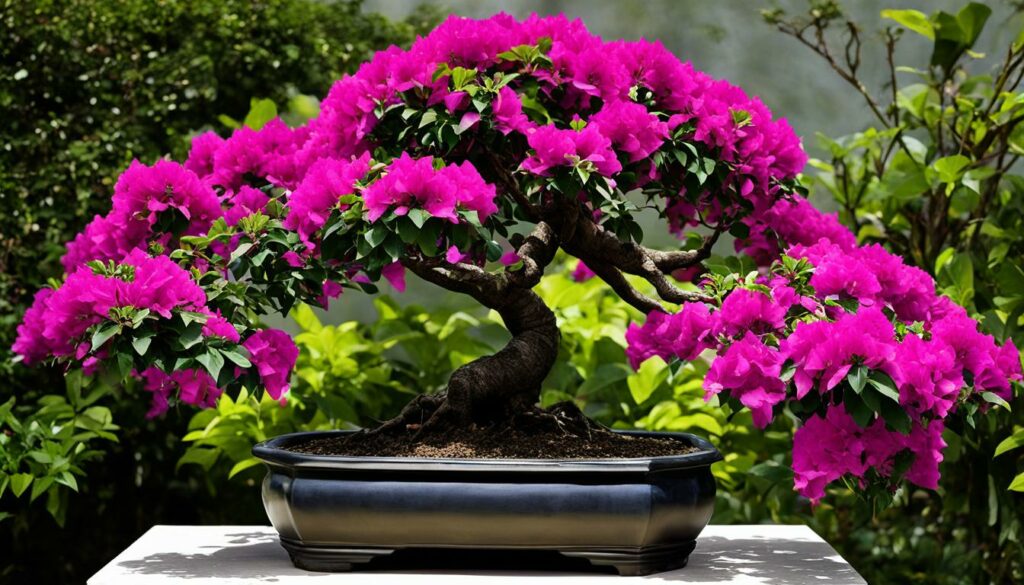Are you looking for a stunning addition to your bonsai collection that captures the essence of tropical beauty in a miniature form? Look no further than the Bougainvillea bonsai. This flowering tropical bonsai species offers a colorful and vibrant addition to any bonsai enthusiast’s collection.
Whether you’re a seasoned bonsai cultivator or just starting, this article will guide you through the various aspects of Bougainvillea bonsai cultivation. From choosing the right species and setting up the ideal environment to pruning and displaying your bonsai, this guide will equip you with the knowledge and skills to care for and appreciate this captivating bonsai species.
Key Takeaways:
- Bougainvillea bonsai is a tropical flowering bonsai species that captures the essence of tropical beauty in miniature form.
- Choosing the right Bougainvillea species for bonsai cultivation involves considering their growth habits, flower colors, and overall aesthetics.
- The ideal environment for optimal growth of Bougainvillea bonsai includes ample light, moderate humidity, and warm temperatures.
- Proper pruning and wiring techniques can help you shape and train your Bougainvillea bonsai to achieve the desired form.
- Watering and fertilization are crucial for the vitality of your Bougainvillea bonsai, and understanding the seasonal care requirements will help you adjust maintenance practices accordingly.
Introduction to Bougainvillea Bonsai
Bougainvillea bonsai, a tropical flowering bonsai species, is a popular choice among bonsai enthusiasts. With its striking aesthetics and lush foliage, Bougainvillea bonsai captures the essence of tropical beauty in a miniature form.
The Bougainvillea plant is native to South America and discovered by French explorer Louis Antoine de Bougainville in the late 18th century. The plant’s unique feature is not its small and delicate flowers, but the colorful bracts that surround them, which can be found in different vibrant hues including pink, purple, red, orange, and yellow, and even variegated combinations.
Bougainvillea bonsai is a unique art that insists on maintaining the character of the original plant while training it into a miniature size. The process requires patience, precision, and attention to detail, but it is ultimately rewarding.
“Bougainvillea bonsai demands a tropical environment, which makes it a popular choice among bonsai lovers who enjoy the exotic vibe.”
Choosing the Right Bougainvillea Species for Bonsai
When choosing the right Bougainvillea species for bonsai, keep in mind their growth habits, flower colors, and overall aesthetics to ensure the best results. There are several species of Bougainvillea that are suitable for bonsai cultivation, each with unique characteristics that make them stand out.
The most popular Bougainvillea species for bonsai include:
| Bougainvillea glabra | Bougainvillea spectabilis | Bougainvillea peruviana |
|---|---|---|
| A dense, shrub-like growth habit with small leaves and pink, purple, or red flowers. | A climbing vine with larger leaves and vibrant pink flowers. | A climbing vine with orange-red flowers and medium-sized leaves. |
Consider the size of your bonsai pot when selecting the right species. Bougainvillea glabra, with its compact growth habit, is well-suited for smaller bonsai pots. Bougainvillea spectabilis and Bougainvillea peruviana, on the other hand, require larger pots to accommodate their climbing nature.
Ultimately, choose a Bougainvillea species that speaks to your sense of beauty and aesthetics, as well as one that aligns with your level of expertise in bonsai cultivation.
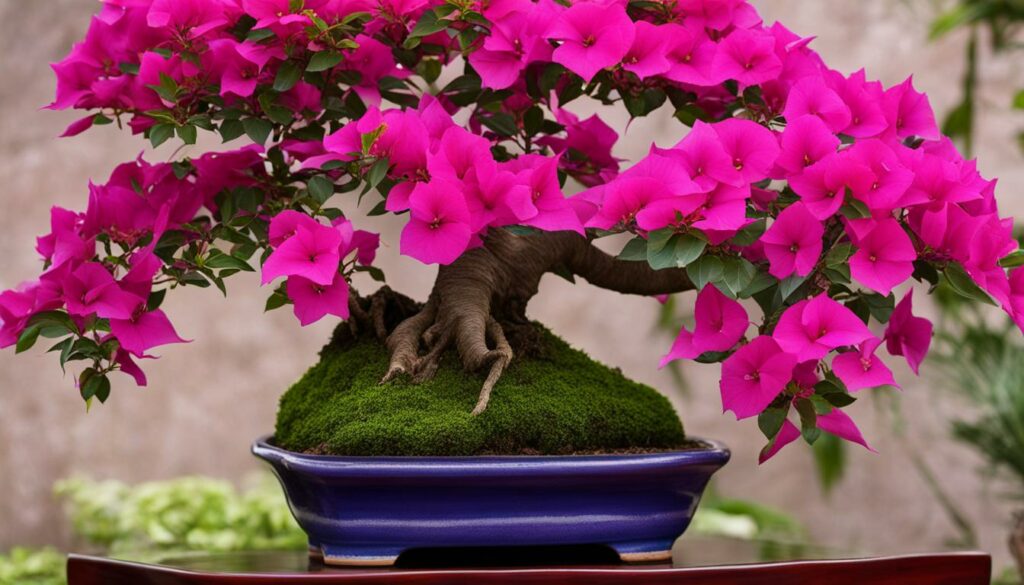
Setting Up the Ideal Environment for Bougainvillea Bonsai
Creating the perfect environment for your Bougainvillea bonsai is crucial for its healthy growth and development. Here’s what you need to know:
- Ideal Lighting Conditions: Bougainvillea bonsai requires a minimum of six hours of direct sunlight every day to thrive. Place the bonsai in a south-facing window or a location where it can receive full sun exposure.
- Temperature Range: Bougainvillea bonsai is a tropical species that requires a warm environment with temperatures between 60°F and 75°F. Keep your bonsai away from cold drafts or sudden temperature changes.
- Humidity Levels: Bougainvillea bonsai requires a humid environment to support its growth. You can use a humidifier or place a tray of water near the bonsai to maintain adequate humidity levels.
By ensuring the Bougainvillea bonsai has the right amount of sunlight, temperature, and humidity, you can promote healthy foliage, vibrant blooms, and a long life for this tropical bonsai species.
Potting and Repotting Bougainvillea Bonsai
Proper potting and repotting techniques are crucial for the health and development of your Bougainvillea bonsai. When potting your bonsai, choose a container that is one size larger than the current container. Root pruning may be necessary if the roots are overcrowded. Before repotting, remove the tree from its current pot and remove any excess soil from the roots.
It’s essential to use suitable potting soil mixes, such as a well-draining soil mix that is rich in organic matter. Avoid using heavy soils that retain water, as they can cause root rot and damage to your bonsai. The best time for repotting is during spring or summer, when the tree is actively growing.
To ensure that your Bougainvillea bonsai remains healthy, repot your tree every 2-3 years to promote healthy growth and prevent root-bound conditions.
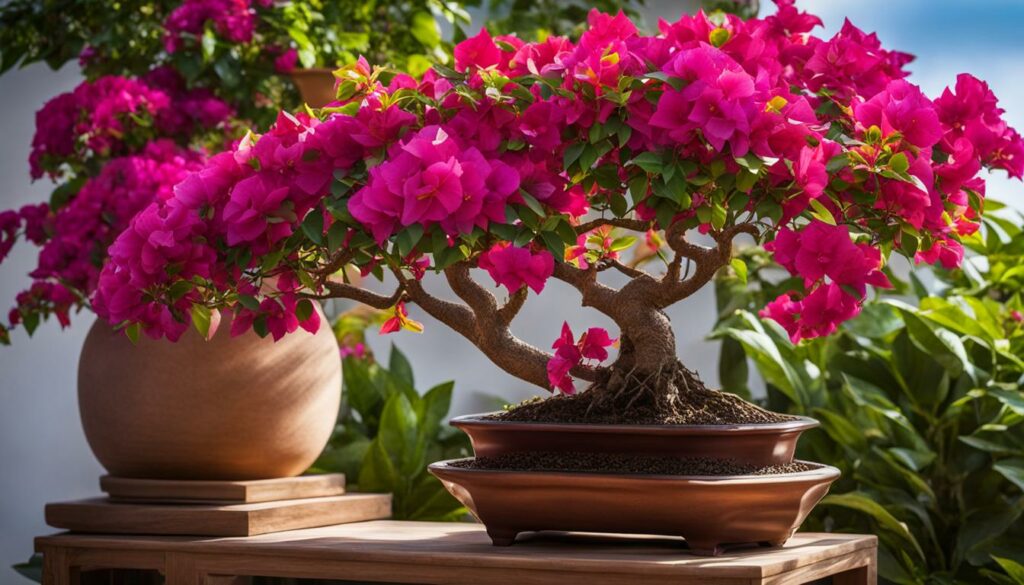
Potting Mix Recipe
Here’s a recipe for a suitable potting mix for your Bougainvillea bonsai:
| Ingredient | Amount |
|---|---|
| Peat Moss | 1 part |
| Coarse Sand | 1 part |
| Perlite | 1 part |
| Composted Pine Bark | 1 part |
Note:
Adjust the mixture according to your specific climate and soil conditions.
“Proper potting is crucial to the health of your bonsai.”
Pruning and Wiring Techniques for Bougainvillea Bonsai
Pruning and wiring are critical techniques used by Bonsai enthusiasts to shape, style, and train their trees. Bougainvillea bonsai is no exception. Proper pruning encourages healthy growth, while wiring helps achieve the desired form and aesthetic shape.
Before embarking on any pruning or wiring, get familiar with the growth habits and characteristics of your Bougainvillea bonsai to determine what style you want to achieve. You can use running, informal upright, cascade, or other styles to create your desired look.
Pruning Techniques:
When pruning Bougainvillea bonsai, use a pair of sharp pruning shears to make clean cuts. Prune the plant during the growing season, cutting back to the first or second leaf. This will encourage new growth, promote a fuller, bushier look, and help manage its size.
Wiring Techniques:
Wiring is done during the dormant season, while the tree is at rest. Use copper or aluminum wiring, as it is less likely to leave marks on the tree. Begin by selecting a trunk or branch that needs shaping and wrap a wire tightly around it. Twist the ends of the wire together and adjust it to form the desired shape. Remove the wire after six months or when it starts to bite into the tree.
Remember that new growth on Bougainvillea bonsai is rapid, so you’ll need to stay on top of pruning and wiring to maintain your desired shape and appearance. Keep in mind that over-pruning or wiring can damage your tree, so it’s crucial to approach both techniques with knowledge and care.
Watering and Fertilizing Bougainvillea Bonsai
Proper watering and fertilizing are essential for the health and vitality of your Bougainvillea bonsai. Water your bonsai tree regularly to ensure that the soil does not become too dry, but avoid overwatering, which can lead to root rot. The frequency of watering depends on various factors such as humidity, temperature, and size of the pot.
One effective technique is to wait until the soil surface becomes slightly dry before watering. Test this by sticking a finger about an inch deep into the soil. If it feels dry, then it is time to water your Bougainvillea bonsai. Water the tree thoroughly until the water flows out from the drainage holes, ensuring that the entire root ball is moistened.
For fertilizing, choose a suitable fertilizer that provides the necessary nutrients for your Bougainvillea bonsai. A balanced, water-soluble fertilizer with equal NPK ratio (nitrogen, phosphorus, potassium) is a good choice. Fertilize your Bougainvillea bonsai once a month during the growing season (spring and summer months), and reduce the frequency during the dormant season (fall and winter months).
Note: Over-fertilization can cause salt build-up in the soil, which is harmful to your Bougainvillea bonsai. Always follow the application instructions on the fertilizer packaging.
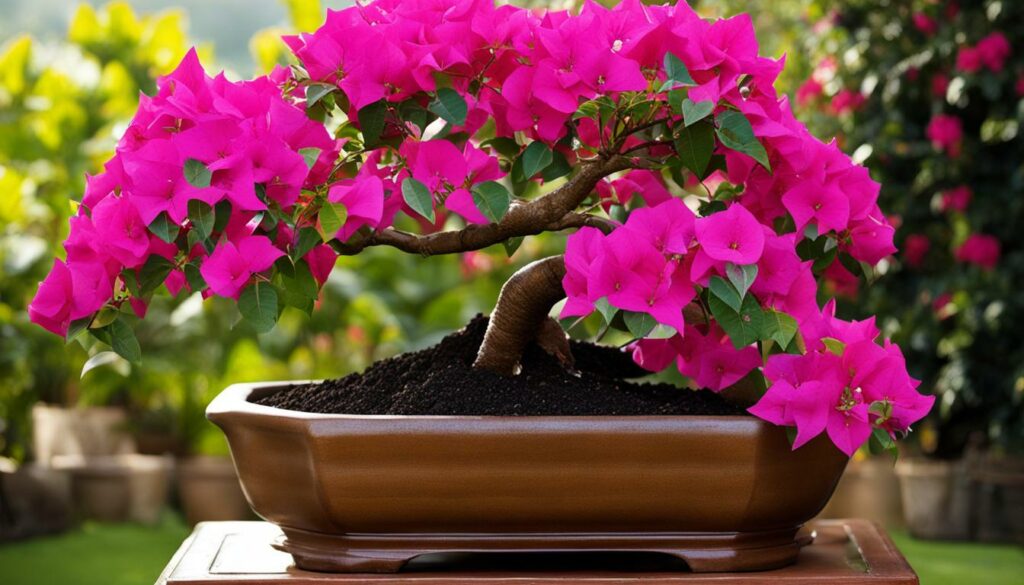
With the right watering and fertilization techniques, your Bougainvillea bonsai will thrive and produce beautiful, vibrant blooms in miniature form.
Preventing and Treating Common Bougainvillea Bonsai Pests and Diseases
As a tropical bonsai species, bougainvillea bonsai may be susceptible to pests and diseases that can impact its health and beauty. By identifying common issues and taking preventive measures, you can ensure that your bougainvillea bonsai thrives.
Common Bougainvillea Bonsai Pests
Some common pests that may affect your bougainvillea bonsai include:
| Pest | Description | Preventive Measures | Treatment Options |
|---|---|---|---|
| Spider Mites | Tiny insects that cause leaf yellowing and wilting. | Consistent watering, use of a humidifier, pruning of infected areas. | Insecticide, application of natural predators (ladybugs). |
| Caterpillars | Larvae that feed on leaves and flowers, causing holes and damage. | Regular inspection, removal of infected areas. | Manual removal, insecticide application. |
| Scale Insects | Small, hard-shelled insects that attach to the bark and suck sap from the plant. | Regular inspection, pruning of infected areas. | Insecticide, manual removal. |
Common Bougainvillea Bonsai Diseases
Some common diseases that may affect your bougainvillea bonsai include:
| Disease | Description | Preventive Measures | Treatment Options |
|---|---|---|---|
| Powdery Mildew | A fungal disease that appears as a white powdery coating on leaves and flowers. | Good air circulation, consistent watering, application of fungicide | Fungicide, pruning of infected areas. |
| Root Rot | A fungal disease that occurs due to overwatering, causing the roots to decay and turn black. | Avoid overwatering, use well-draining soil, regular soil inspection. | Pruning of infected roots, use of a fungicide. |
Seasonal Care Tips for Bougainvillea Bonsai
Proper care and maintenance of Bougainvillea bonsai are crucial to its growth and blooming cycles. Adjusting your practices according to the season will ensure your tropical bonsai is thriving all year round.
Spring
In spring, Bougainvillea bonsai is entering its active growth phase. It is crucial to ensure it receives sufficient sunlight, at least six hours a day, and consistent watering to support healthy foliage and root development. Use a balanced fertilizer, with an NPK ratio of 10-10-10, to supplement the soil’s nutrients.
Summer
Summer is the peak season for Bougainvillea bonsai’s blooming cycle. It requires adequate watering, preferably daily, to cope with the higher temperatures and humidity levels. Protect it from direct afternoon sunlight, especially during heatwaves, which can damage the delicate foliage. Use a high-phosphorus fertilizer, with an NPK ratio of 5-10-5, to encourage flowering.
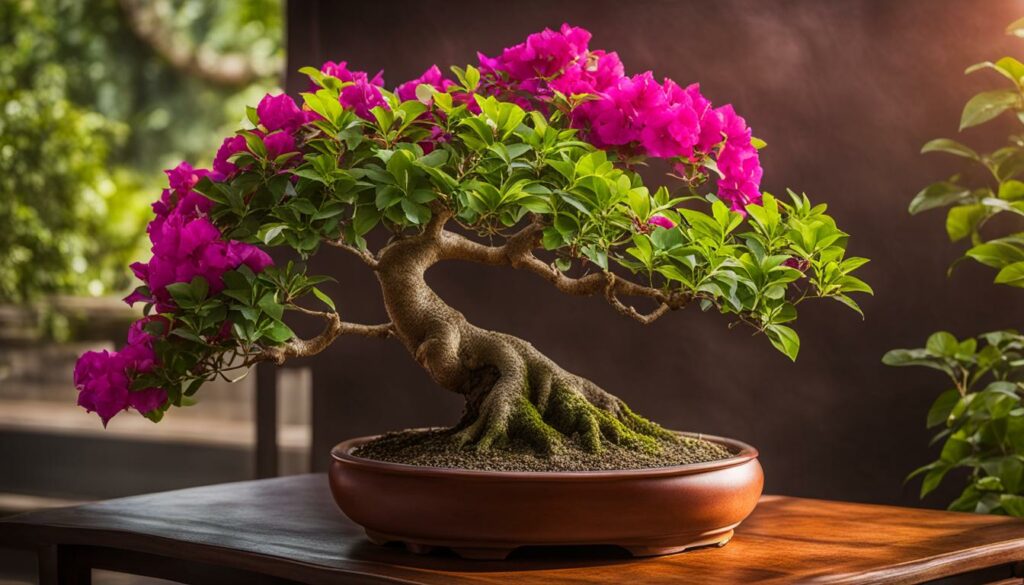
Fall
Fall is the dormant period for Bougainvillea bonsai, signaling the end of the blooming cycle. Gradually reduce its watering frequency and fertilizer applications. Ensure it receives sufficient indoor lighting and is protected from frost damage, which can be fatal to tropical bonsai species.
Winter
Winter is a challenging season for Bougainvillea bonsai, especially in cold climates. Protect it from freezing temperatures, icy winds, and sudden temperature drops. Increase its indoor lighting exposure and monitor its watering needs, ensuring the soil stays moist, but not waterlogged. Avoid fertilizing during winter.
Styling and Displaying Bougainvillea Bonsai
Once you have cultivated your Bougainvillea bonsai to its full beauty, it’s time to showcase it in a fitting way. Here are some creative styling and display ideas to enhance the overall visual impact of your tropical bonsai:
- The Minimalist Approach: Let your Bougainvillea bonsai be the centerpiece of a clean and simple display. Choose a single-colored pot that complements the flower color and place it on a wooden stand for a timeless touch.
- The Traditional Display: Place your Bougainvillea bonsai on a wooden table, surrounded by small accessories such as stones, plants, or miniature figurines. You can also create a backdrop with a Japanese-style screen to underscore the Asian heritage of bonsai.
- The Modern Twist: Add a creative twist to your Bougainvillea bonsai display with contemporary accessories such as colored stones, glass terrariums, or metal frames. You can also use LED lights to highlight the colorful flowers and leaves of your tropical bonsai.
When choosing the right display for your Bougainvillea bonsai, keep in mind the overall aesthetics of your space and the mood you want to convey. Experiment with different styling options until you find the perfect one that resonates with you.
Pros and Cons of Different Bougainvillea Bonsai Styling and Display Approaches
| Styling Approach | Pros | Cons |
|---|---|---|
| The Minimalist Approach | Highlights the beauty of the Bougainvillea bonsai, emphasizing its natural form, and color. | May appear too simplistic or unimpressive in larger spaces or when surrounded by other visually competing elements. |
| The Traditional Display | Provides a traditional and cultural context for the Bougainvillea bonsai, adding authenticity and depth to the display. | May appear cluttered or busy with too many accessories and can detract from the beauty of the tropical bonsai. |
| The Modern Twist | Allows for creative and personalized expression, emphasizing the contemporary aspect of bonsai as an art form. | May appear inconsistent with the traditional and cultural roots of bonsai, not aligning with the aesthetics of some enthusiasts. |
Explore different options and experiment with different approaches to find the Bougainvillea bonsai display that resonates with you.
Perfect your display to align with the aesthetics of your space and your personal style. The lush and vibrant Bougainvillea bonsai is a stunning tropical bonsai species that can add a touch of exotic beauty to your bonsai collection.
Showcasing the Tropical Beauty: Bougainvillea Bonsai Inspiration
Are you looking for inspiration to help you create a stunning Bougainvillea bonsai tree? Look no further than these gorgeous examples from bonsai enthusiasts and masters.
One inspiring example is the Bougainvillea bonsai tree by bonsai artist John Naka. The tree features a stunning arrangement of cascading Bougainvillea branches and vibrant pink flowers.
Another beautiful Bougainvillea bonsai is the one created by Susumu Nakamura, which features a captivating combination of red and orange flowers. The bonsai’s canopy is shaped to resemble a graceful dome, creating a visually stunning addition to any collection.
If you are looking for a more unique and artistic approach, consider the Bougainvillea bonsai tree by bonsai artist David Nguy. David’s Bonsai features a series of twisted and gnarled trunks, creating a beautiful and dramatic addition to any display.
These stunning examples showcase the endless creative possibilities of the Bougainvillea bonsai. Whether you want a traditional bonsai design or something more avant-garde, the Bougainvillea bonsai is a captivating tropical species that is sure to impress.
Conclusion
Now that you have explored the lush beauty of the Bougainvillea bonsai, you are equipped with the knowledge needed to cultivate and appreciate this tropical flowering bonsai species. Remember to choose the right species for your needs, provide the ideal environment, pot and repot your tree correctly, and prune and wire it to achieve the desired form.
Additionally, be sure to water and fertilize your bonsai tree appropriately and take preventive measures against pests and diseases. Adjust your care practices according to the seasons and style and display your Bougainvillea bonsai creatively.
As you embark on this rewarding journey of cultivating and enjoying your miniature tropical tree, remember to appreciate its beauty and the artistic expression it can bring to your living space. Witness the stunning examples of Bougainvillea bonsai from enthusiasts and masters alike, and showcase your own creation with pride.
FAQ
What is a Bougainvillea bonsai?
A Bougainvillea bonsai is a miniature version of the Bougainvillea tree, which is known for its vibrant and colorful flowers. It is created through careful pruning and training techniques to maintain its small size and achieve the desired aesthetic form.
How do I choose the right Bougainvillea species for bonsai?
When selecting a Bougainvillea species for bonsai, consider factors such as growth habits, flower colors, and overall aesthetics. Look for compact and manageable varieties that are suitable for bonsai cultivation, and choose species that thrive in your climate.
What are the environmental requirements for Bougainvillea bonsai?
Bougainvillea bonsai thrives in a tropical environment. It requires bright sunlight, warm temperatures, and high humidity levels. It is important to provide adequate lighting conditions and protect the bonsai from cold drafts or extreme temperature fluctuations.
How often should I water and fertilize my Bougainvillea bonsai?
Bougainvillea bonsai should be watered when the top inch of the soil feels dry. The frequency may vary depending on the climate and potting mix. During the growing season, regular fertilization with a balanced bonsai fertilizer is recommended to support healthy growth and blooming.
How do I prune and shape my Bougainvillea bonsai?
Pruning and shaping Bougainvillea bonsai can be done throughout the year. Remove any dead, diseased, or overgrown branches to maintain the desired shape and promote new growth. Wiring techniques can also be used to guide the branches into the desired position.
What are common pests and diseases that affect Bougainvillea bonsai?
Bougainvillea bonsai can be susceptible to pests such as aphids, scale insects, and caterpillars. Diseases such as powdery mildew and root rot may also occur. Regular inspection, proper hygiene, and appropriate preventive measures can help prevent and control these issues.
How do I care for Bougainvillea bonsai during different seasons?
Adjust your care practices based on the seasons. During the growing season, provide ample sunlight, water, and regular fertilization. In winter, protect the bonsai from cold temperatures and reduce watering. Prune and shape the bonsai as needed throughout the year.
How do I style and display my Bougainvillea bonsai?
When styling your Bougainvillea bonsai, consider traditional bonsai aesthetics or explore more modern and creative approaches. Choose a suitable bonsai display that complements the beauty and characteristics of the tree, such as a ceramic pot or a custom-designed bonsai stand.
Can you provide inspiration for Bougainvillea bonsai styling?
There are numerous examples of stunning Bougainvillea bonsai created by enthusiasts and masters. You can find inspiration through books, online resources, or visiting bonsai exhibitions. Explore different styles and techniques to reflect your artistic vision and showcase the tropical beauty of the Bougainvillea bonsai.
